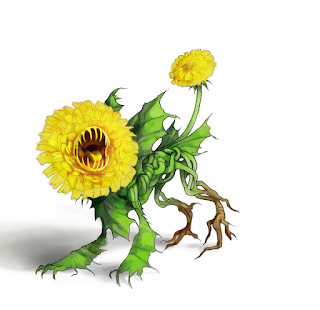At any rate, today's monster is a skeleton that requires bones to keep itself going, and it will go after anything and everything with a skeletal structure to fulfill that need. So, you could throw this in a tomb or graveyard, and it will have plenty of fodder beyond the PCs.
I hope you enjoy the osteohulk, and I'll see you next week with another monster!
This skeletal creature
approximates a gigantic humanoid skeleton in appearance, but the bones composing
it are from a variety of creatures. It has a pair of overlarge wings also fashioned
from mismatched bones.
Osteohullk CR 14
XP 38,400
NE Large undead
Init +2; Senses darkvision 60 ft.; Perception
+26
DEFENSE
AC 29, touch 11,
flat-footed 27 (+2 Dex, +18 natural, –1 size)
hp 199 (19d8+114)
Fort +12, Ref +10, Will +15
Defensive Abilities
channel resistance +4, positive energy cage; DR 15/bludgeoning and good; Immune
cold, electricity, undead traits; Resist
fire 20
OFFENSE
Speed 40 ft., fly
60 ft. (poor)
Melee bite +24
(2d8+10/19–20 plus bleed), 2 claws +24 (2d6+10/19–20 plus bone extraction), 2
wings +21 (1d8+5)
Space 10 ft.; Reach 10 ft.
Special Attacks bleed
(2d6), breath weapon (60-ft. cone, 12d10 bludgeoning, piercing, and slashing damage,
Reflex DC 25 for half, usable every 1d4 rounds)
STATISTICS
Str 31, Dex 14, Con —, Int 8, Wis 19, Cha 23
Base Atk +14; CMB +25; CMD 37
Feats Dazzling
Display, Flyby Attack, Hover, Improved Critical (bite, claw), Lightning
Reflexes, Multiattack, Power Attack, Shatter Defenses, Weapon Focus (bite, claw)
Skills Climb +21,
Fly +10, Intimidate +28, Perception +26
ECOLOGY
Environment any
Organization solitary
or troop (2–12 plus 10–100 skeletons)
Treasure none
SPECIAL ABILITIES
Bone Extraction (Su)
When an osteohulk strikes a creature with a skeleton, the target must attempt a
DC 25 Fortitude save or lose parts of its skeletal structure. On a failed save,
the target takes 1d4 points of Strength damage and 1d4 points of Dexterity
damage, and, for each point of damage dealt, the osteohulk heals 5 hit points or
gains 5 temporary hit points for 1 hour (up to a maximum number of temporary
hit points equal to its full normal hit points). If the target rolls a natural
1 on its Fortitude save, the osteohulk heals 40 hit points or gains 40
temporary hit points, and the target loses the entirety of its skeleton and
becomes immobile, reducing its Strength and Dexterity to 0; a creature made up
only of bones (such as a skeleton) is destroyed. This ability also works on
objects comprised of bone. Creatures that have taken damage from this ability
cannot have the damage restored until they are the recipient of a regenerate spell or replace their lost
bones through some other means. The save DC is Charisma-based.
For every 50 temporary hit points an osteohulk possesses, it
gains the giant creature simple template. The template stacks with itself (applying
the template twice if the osteohulk has between 100 and 149 temporary hit
points, and three times if the osteohulk has 150 or more temporary hit points).
It loses an application of the template as its temporary hit points are reduced
below each 50-point threshold.
Breath Weapon (Su)
When an osteohulk uses its breath weapon, it deals 12 points of damage to itself.
Positive Energy Cage
(Su) If an osteohulk succeeds at its Will save against spells or effects
that deal positive energy damage, it takes no damage and stores the energy in a
cavity within its body. It then takes 1 round to convert the energy to negative
energy, after which it can release the energy as if it used channel energy with
a cleric level equal to its Hit Dice (typically dealing 10d6 negative energy
damage and requiring a DC 25 Will save for half damage).
Osteohulks are the result of profane rituals performed over the
site of a horrific battle or mass murder (sometimes carried out by the same creatures
responsible for the ritual). The bones from the multivarious corpses knit together
to create surprisingly mobile undead monsters which spring into existence
craving more bone matter. Since they are less than subtle creatures, they usually
act as cannon fodder for powerful undead generals. They act as the centerpiece
of undead shock troops, otherwise made up of mindless undead providing a
vanguard for the troop and fodder for the osteohulks, which sweep up the remnants
into their masses, so they can become more powerful as they reach their
enemies. Enterprising commanders place osteohulks with trolls and other
regenerating creatures, so the undead hulks can increase their size without causing
undue harm to the overall squad.
When a typical osteohulk is encountered, it stands roughly 10
feet tall and weighs 800 pounds. Its size and weight fluctuate as it adds to
its mass and loses bones during combat.



